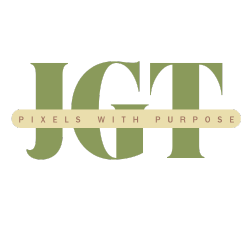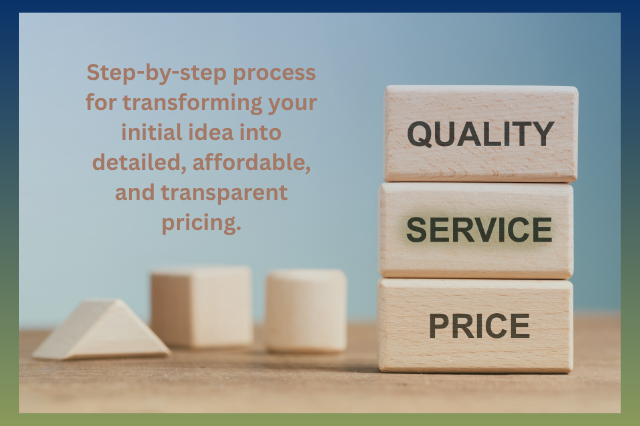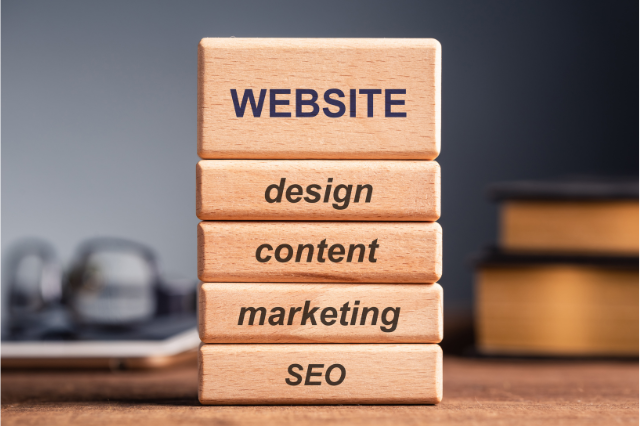From Idea to Quote: A Transparent Look at Freelance Web Development Pricing
Web Development Pricing Guide:
The Factors That Determine Your Final Quote
You have a brilliant idea!!!
It’s the kind of idea that keeps you up at night, a new website that will revolutionize your brand, a custom web app that will streamline your operations, or an online store ready to take on the market.
But then, reality sets in. You need a professional to build it.
So you start reaching out to developers or designers, and one question looms larger than all others:
“How much will this cost?”
And the answers are often… vague.
“It depends.”
“I’ll need to get back to you with an estimate.”
“What’s your budget?”
If you’ve ever felt frustrated by this lack of clarity, you’re not alone.
The “it depends” answer, while often honest, can feel like a brush-off.
The truth is, giving an accurate price for a custom project without a thorough process is like a contractor giving a quote to build a house without seeing the blueprints.
So, why the mystery?
In this post, I’m pulling back the curtain completely.
I’ll walk you through my exact, step-by-step process for transforming your initial idea into a detailed, fair, and transparent quote.
My goal is to show you that a thorough pricing process isn’t a barrier; it’s the foundation of a successful partnership and a project that delivers real value.
Let’s demystify the journey from your vision to my proposal.
The 5-Step Process from Your Vision to My Proposal
A great project quote isn’t a random number.
It’s the final result of a diagnostic process, where I deeply understand your problem before proposing a solution.
This is how I ensure that when you invest your resources, you’re investing in a solution that will actually work.
Step 1:
The Deep Dive, Our Initial Strategy Session
This first conversation is the most critical part of the entire process. It’s not a sales call; it’s a strategic discovery session.
My goal here isn’t to give you a number, it’s to understand the “why” behind your “what.”
I come to this call with a tailored questionnaire designed to uncover the core of your project.
The better I understand your business, the better the solution I can build.
Here are the key areas we explore
Project Goals & Objectives:
What is the single primary purpose of this project? (e.g., generate leads, sell products directly, build an email list, reduce customer service calls?)
What does success look like in 6 months? In a year?
Target Audience:
Who are we trying to reach and influence?
What are their pain points, and how will this project solve them?
Core Functionalities & Must-Haves:
What are the absolute non-negotiable features for launch?
What are the “nice-to-haves” that could live in a future phase?
Content & Branding:
Do you have existing brand guidelines, copy, and imagery?
Will you need help with copywriting or sourcing visuals?
Technical & Business Constraints:
Do you have an existing hosting provider?
Are there any third-party tools (like a CRM, email marketing platform, or payment gateway) we need to integrate with?
The Client Value:
This phase ensures we are perfectly aligned on the vision and strategic goals before we talk about money.
It transforms you from a client into a partner, and it ensures that the solution we build is designed for your specific audience and business objectives.
Step 2:
Scoping the Solution : Your Project Blueprint
After our discovery call, I translate everything we discussed into a concrete, written plan: the Project Scope Document (or Statement of Work).
This document is our project blueprint, it becomes the single source of truth that prevents misunderstandings and keeps us on track.
A comprehensive scope document includes:
Project Overview: A summary of the goals, audience, and overall vision we defined in Step 1.
Detailed Feature & Page List: This is where “a new website” becomes a specific, actionable list. For example:
A custom-designed homepage with a hero section, feature grid, and testimonial slider.
An “About Us” page with team member profiles.
A “Services” page with an integrated booking calendar (using Calendly).
A password-protected client portal.
A blog with 5 initial posts.
Clear Deliverables: What will I physically hand over to you?
A fully responsive, tested website on a chosen platform.
Admin training session (1 hour).
Source code and design files.
Assumptions & Exclusions: This is arguably the most important part for preventing “scope creep.” I am explicitly clear about what is not included.
Example: “This price assumes all final copy and images will be provided by the client. It does not include ongoing hosting, maintenance, or stock photography fees.”
The Client Value: The scope document eliminates guesswork.
You know exactly what you’re getting, and I know exactly what I’m building.
It’s our mutual agreement that protects both our interests and ensures a smooth, predictable project flow.
Step 3:
The Technical Architecture: Building on the Right Foundation
With a clear blueprint in hand, I now put on my architect hat. My favorite part of the process.
This is the behind-the-scenes phase where I evaluate the best tools and technology to bring your project to life.
My job is to choose a foundation that is not only right for today but will also scale with your success.
I assess the project needs against several factors to recommend a technology stack:
Project Complexity & Type:
Marketing/Brochure Site: Often best served by WordPress, Webflow, or a static site generator for speed and easy content updates.
Complex Web Application: Requires a robust framework like React, Vue.js, or Node.js to handle dynamic user interactions and data.
E-commerce Store: We evaluate platforms like Shopify (for all-in-one ease), WooCommerce (for deep WordPress integration), or a custom solution for unique needs.
Content Management Needs:
Does your team need to easily update blog posts, team bios, or portfolio items? If so, a user-friendly CMS is non-negotiable.
Performance & Scalability:
What are the long-term traffic expectations? The architecture must be able to grow with your business without needing a complete rebuild.
Integration Requirements:
Do we need to connect to your CRM (like HubSpot), email service provider (like Mailchimp), or a custom database? The stack must play nicely with these tools.
The Client Value: You are hiring an expert not just to write code, but to make strategic technical decisions.
This assessment ensures you aren’t overpaying for complexity you don’t need or, worse, investing in a platform that will hold you back in a year.
It’s about building a solution that is efficient, maintainable, and future-proof.
Step 4:
The Reality Check: Meticulous Time Estimation
This is where the blueprint and technical plan meet reality.
I break the entire project down into its constituent parts and estimate the time required for each.
This granular approach is what separates a professional quote from a wild guess.
Here’s my process for time estimation:
I break the project into key phases:
UX & Design
Front-End Development
Back-End Development
Content Integration & Population
Testing & Quality Assurance (QA)
Launch & Hand-off
Within each phase, I list every individual task. For the “UX & Design” phase of a homepage, this might look like:
Mood board & style tile creation
Desktop wireframe
Mobile wireframe
High-fidelity desktop mockup
High-fidelity mobile mockup
Client review and revision rounds (2 rounds included)
I assign a realistic time estimate to each task, based on my years of experience with similar projects.
The Professional Buffer: The Unseen Guardian of Your Project
Once I have the total hours from all tasks, I add a project buffer (typically 10-15%). This is not a “padding” to make more money.
It is a crucial part of professional project management that accounts for the inevitable unknowns, such as:
Additionally, reasonable revision requests.
Time spent in project communication and management.
Unforeseen technical hiccups during integration.
Browser compatibility troubleshooting.
Being transparent about this buffer is a sign of a seasoned professional. It ensures the project timeline and budget remain realistic, even when small challenges arise.
Step 5:
The Final Proposal: Your Transparent Investment
We’ve reached the final step…
All the discovery, planning, and estimation culminate in a clear, comprehensive proposal.
This is where I present not just a price, but a vision for our partnership and your project’s success.
The final quote is calculated with a simple, transparent formula:
(Total Estimated Hours + Project Buffer) x Fixed Project Rate or Hourly Rate = Your Project Quote
Your proposal document will clearly outline:
A Recap of Our Discovery: Re-stating your goals shows I was listening and connects the price back to your business objectives.
The Detailed Scope of Work: This is the blueprint from Step 2, so you can see exactly what’s included.
The Total Investment & Payment Schedule:
A clear total price.
A sensible payment schedule (e.g., 50% to start, 25% at a key milestone, 25% upon launch).
Project Timeline & Key Milestones: You’ll see a proposed timeline for the project, with key dates for reviews and feedback.
My Terms & Conditions: This covers intellectual property, confidentiality, and standard procedures.
Reframing the “Price”: By the time you receive this proposal, the number on the page is no longer a mysterious cost.
It is a direct reflection of the detailed plan we built together.
It’s not an expense; it’s a strategic investment in a partner dedicated to achieving your business goals through a high-quality, effective digital product.
Let's Build Something Great Together
The journey from a spark of an idea to a formal quote shouldn’t be a black box.
As we’ve walked through, it’s a meticulous, transparent process of diagnosis and planning.
A detailed quote is your first and best indicator of a professional who cares about your project’s success as much as you do.
You now have a behind-the-scenes look at my process, a process designed to build trust, ensure clarity, and lay the groundwork for a flawless project execution.
So, what’s the next step?
If you have a project in mind and this approach resonates with you, I invite you to take the first step.
📅 Schedule your free, no-obligation discovery meeting today. Let’s talk about your vision, your goals, and how we can turn your idea into a detailed, actionable plan.
📝 Not quite ready to talk? Download my free Project Planning Checklist to start organizing your thoughts and requirements on your own time. Get a head start on the discovery phase and feel fully prepared for your next conversation with a developer.
I look forward to collaborating with you:)
Take a look at the different types of websites and their functions here.
.





